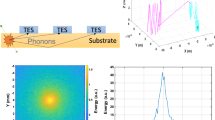Abstract
For the future satellite mission at the second sun–earth Lagrangian point (L2), we need to mitigate phonon propagation created by cosmic rays to superconducting detectors. We simulate phonon propagation in silicon substrate and show that putting a metal layer on the substrate or making hole in the substrate reduces the propagation. We also show a function which shows the response of a TES bolometer on a substrate. To validate these theoretical expectations, we make irradiation tests using two types of superconducting detectors: transition edge sensor bolometers and kinetic inductance detectors. From the tests, we show that putting metal can reduce correlations between detectors and number of hit events from charged particles.









Similar content being viewed by others
Notes
In the simulation, we prepare block of silicon surrounded by phonon absorbing walls. Then, we generate phonons in a position and see how much phonons are propagated in the other position across the area with mitigation methods (including no mitigation). Because the simulation parameters are not optimised, we only see the relative effects of mitigation ideas.
As described in Appendix 1, A is related to amplitude of rising signal, B is related to amplitude of dropping signal, \(\tau _A\) is related to substrate-bath time constant, and \(\tau _B\) is related to TES-substrate time constant.
References
M. Hazumi et al., Litebird: a satellite for the studies of b-mode polarization and inflation from cosmic background radiation detection. J. Low Temp. Phys. 194(5), 443–452 (2019). https://doi.org/10.1007/s10909-019-02150-5. ISSN 1573-7357
K.D. Irwin, G.C. Hilton, Transition-Edge Sensors (Springer, Berlin, 2005), pp. 63–150. https://doi.org/10.1007/10933596_3. ISBN 978-3-540-31478-3
Planck HFI Core Team, Planck early results VI The high frequency instrument data processing. Astronomy & Astrophysics 536, A6 (2011). https://doi.org/10.1051/0004-6361/201116462
D. Brandt et al., Monte Carlo simulation of massive absorbers for cryogenic calorimeters. J. Low. Temp. Phys. 167, 485–490 (2012). https://doi.org/10.1007/s10909-012-0480-3
D. Brandt et al. Semiconductor phonon and charge transport Monte Carlo simulation using Geant4. arXiv: 1403.4984 (2014)
E. Bagli, M. Asai, D. Brandt, A. Dotti, V. Guidi, D.H. Wright, A model for the interaction of high-energy particles in straight and bent crystals implemented in Geant4. Eur. Phys. J. C 74(8), 2996 (2014). https://doi.org/10.1140/epjc/s10052-014-2996-y
H. Ishitsuka, M. Ikeno, S. Oguri, O. Tajima, N. Tomita, T. Uchida, Front-end electronics for the array readout of a microwave kinetic inductance detector towards observation of cosmic microwave background polarization. J. Low Temp. Phys. 184(1), 424–430 (2016). https://doi.org/10.1007/s10909-015-1467-7. ISSN 1573-7357
J. Suzuki, H. Ishitsuka, K. Lee, S. Oguri, O. Tajima, N. Tomita, E. Won, Development of a data acquisition system for kinetic inductance detectors: wide dynamic range and high sampling rate for astronomical observation. J. Low Temp. Phys. 193(3), 562–569 (2018). https://doi.org/10.1007/s10909-018-2033-x. ISSN 1573-7357
K. Hattori, Y. Akiba, K. Arnold, D. Barron, A.N. Bender, A. Cukierman, T. de Haan, M. Dobbs, T. Elleflot, M. Hasegawa, M. Hazumi, W. Holzapfel, Y. Hori, B. Keating, A. Kusaka, A. Lee, J. Montgomery, K. Rotermund, I. Shirley, A. Suzuki, N. Whitehorn, Development of readout electronics for polarbear-2 cosmic microwave background experiment. J. Low Temp. Phys. 184(1), 512–518 (2016). https://doi.org/10.1007/s10909-015-1448-x. ISSN 1573-7357
A. Suzuki, K. Arnold, J. Edwards, G. Engargiola, A. Ghribi, W. Holzapfel, A.T. Lee, X.F. Meng, M.J. Myers, R. O’Brient, E. Quealy, G. Rebeiz, P. Richards, D. Rosen, P. Siritanasak. Multichroic dual-polarization bolometric detectors for studies of the cosmic microwave background, in Millimeter, Submillimeter, and Far-Infrared Detectors and Instrumentation for Astronomy VI, vol. 8452, ed. by W.S. Holland (International Society for Optics and Photonics, SPIE, 2012), pp. 1038–1047. https://doi.org/10.1117/12.924869
Acknowledgements
This work was supported in part by Japan Society for the Promotion of Science (JSPS) KAKENHI Grant Numbers JP18H04361 and JP15H05891.
Author information
Authors and Affiliations
Corresponding author
Additional information
Publisher's Note
Springer Nature remains neutral with regard to jurisdictional claims in published maps and institutional affiliations.
Appendices
Appendix 1: Modelling of a TES Bolometer
From the model of Fig. 2, we created simultaneous differential equations of temperatures of a TES bolometer and a silicon substrate:
where \(\Delta T_1\) and \(\Delta T_2\) are change in temperature of silicon substrate and TES bolometer, \(\varLambda _{1,2} = \lambda _{1,2}+\frac{G_1+G_2}{C_1}\),
and
If we consider an initial state that the energy (\(E_{\rm in}\)) is injected into a silicon substrate at \(t_0\),
If we consider an initial state that the energy (\(E_{\rm in}\)) is injected into a TES bolometer at \(t_0\),
Appendix 2: Finding Dropped KID
Because we only have nine resonances out of ten designed KIDs, we develop a way to identify one dropped KID. For this analysis, we apply the same veto as described in Sec3.2.
After the veto, we calculate the correlation between ith and jth KIDs with triggered time index from ith KID, \(\mathrm {Corr}(d_i (t_i), d_j (t_i))\). This means that \(\mathrm {Corr}(d_i (t_i), d_j (t_i))\) and \(\mathrm {Corr}(d_j (t_j), d_i (t_j))\) are different. Then, we calculate all the correlations between all bolometers. The correlations without f1 are plotted in Fig. 10. We checked all the cases with correlation plots and finally find f1 KID is dropped. As shown in Fig. 10, f2, f4, f7, and f9 have strong correlations as we expect from the design 4.
Digraphs of correlations between KIDs. The vector from \({fi}\) to \({fj}\) shows the correlation of \({\mathrm {Corr}}(d_i (t_i), d_j (t_i))\). The red vector shows the case that \(i\le j\), and the blue vector shows the other case. The width of vectors is related to \(\propto 1.3\times 5.0^{\mathrm {Corr}/0.5}\) (Color figure online)
Rights and permissions
About this article
Cite this article
Minami, Y., Akiba, Y., Beckman, S. et al. Irradiation Tests of Superconducting Detectors and Comparison with Simulations. J Low Temp Phys 199, 118–129 (2020). https://doi.org/10.1007/s10909-020-02393-7
Received:
Accepted:
Published:
Issue Date:
DOI: https://doi.org/10.1007/s10909-020-02393-7





